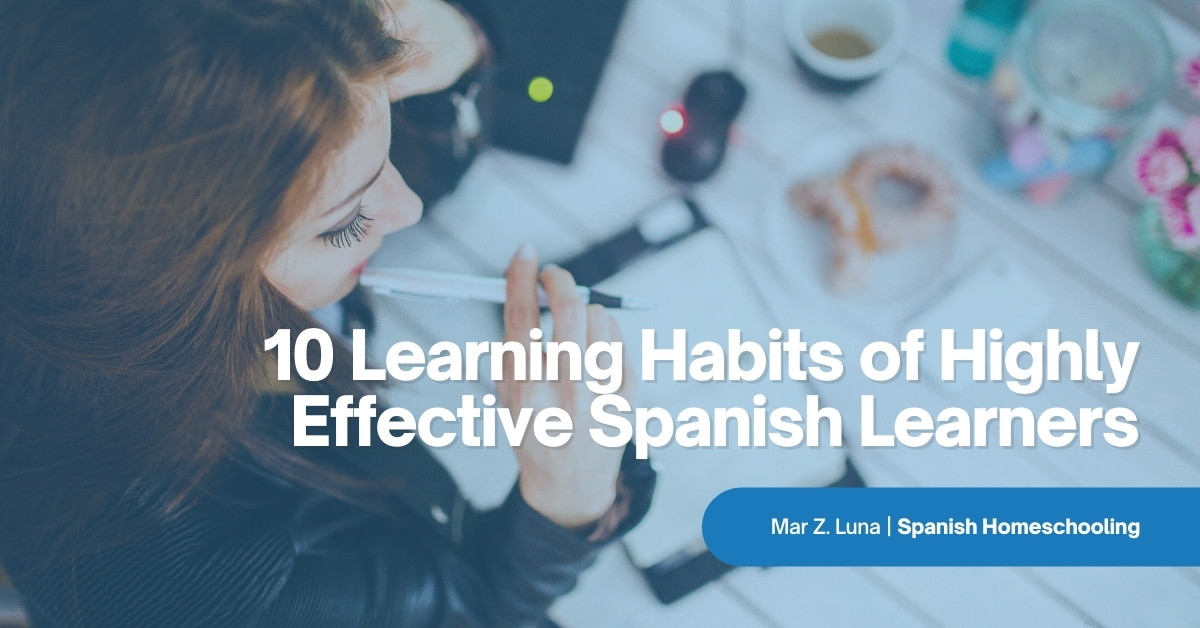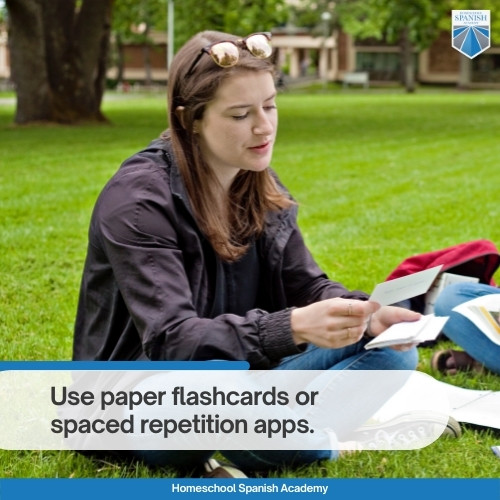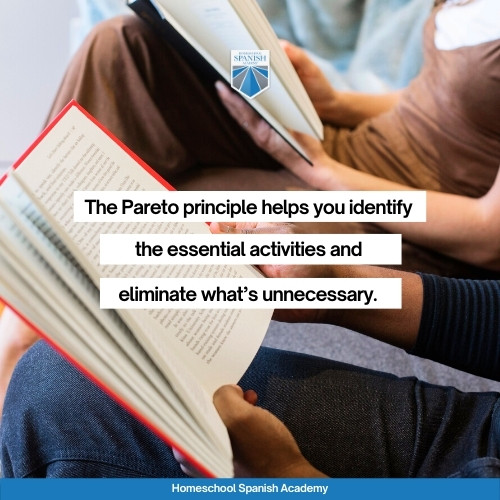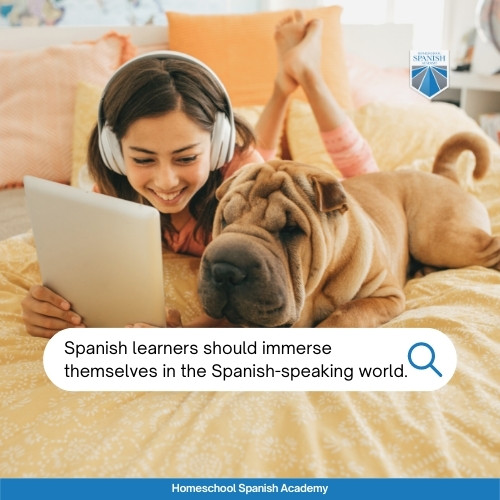
10 Learning Habits of Highly Effective Spanish Learners
When it comes to learning how to study Spanish, it’s all about taking the time to get to know yourself. The most effective Spanish learning habits involve actionable steps that help you to reach your goal. They make your learning process effective yet fun! Language learning doesn’t need to be stressful or boring. In fact, with the right tools and self-knowledge, it can be one of the best experiences of your life.
You’ll achieve success if you commit to the process and show up on a regular basis. Read on to learn some of the best habits I’ve observed in students who’ve achieved success and become fully bilingual.
10 Learning Habits of Successful Spanish Learners
Check out these effective learning habits with actionable tips to get the most out of your learning experience. Let’s dig in!
1. Spaced Repetition
Spaced repetition is a learning habit that allows you to spend less time studying and helps you retain more information.
This technique for Spanish learners is about spacing out your study sessions. You also introduce time intervals into your regular study sessions to remember more. It’s all about giving your brain a break so that it can remember everything that you’ve learned in your session.
Use paper flashcards or spaced repetition apps. Set the timer on your phone to stop every 10 minutes or so and remember the information you just learned.
Spaced repetition creates the spacing effect, a memory phenomenon that shows how our brains work more effectively when you don’t overwhelm it with too much information. Create space between your study sessions until you’re ready for more!
Hand-picked for you: How to Use Spaced Repetition to Learn Spanish Faster

2. Pomodoro Technique
Another famous technique for Spanish learners is the Pomodoro Technique. Francesco Cirillo developed this method in the 1980s . He was struggling to focus on his studies and felt overwhelmed. He found a “pomodoro” (tomato in Italian) shaped timer, and that’s where the name came from.
You’ll need a timer and a to-do list for this technique. Set your timer for 15 to 25 minutes and focus on a single task until it goes off. After four pomodoros, take a five-minute break to let the information sink in. This learning habit is specific, simple, and useful.
Hand-picked for you: How to Use the Pomodoro Study Technique
3. Pareto Principle
The Pareto principle is a learning technique based on the idea that 20% of our activities account for 80% of our results. This strategy helps you identify the essential activities and eliminate what’s unnecessary.
This time management learning habit helps you prioritize your time and use it more effectively. I recommend studying at a time when you’re feeling energized so that you can take advantage of your time while you’re studying Spanish.

4. Only Use Spanish During Your Study Sessions
When I became a language instructor, I was taught to only use the target language. No matter what, never speak any other language in the classroom but the one you’re trying to learn. Even if you’re a beginner, you can do anything to express yourself but speak any other language in class. This technique is effective because it forces students to think in the target language as soon as possible.
Use images, charades, props, and anything you need to express yourself effectively. It’s not easy at first, but it’s amazing to see how easily students adapt and learn to follow this rule. It forces them to get creative and immerse themselves in the language from the start.
It’s okay to take notes in both languages, but when it comes to speaking in the classroom, using the target language exclusively is one of the most effective techniques.
5. Listen to Podcasts and Write Down New Words
Spanish learners should immerse themselves in the Spanish-speaking world. One of my favorite tools for this is podcasts.
It’s not only about listening to the podcasts, but also taking notes while you listen. If the podcast is too fast-paced, you can slow down the speed on many podcast apps.
Keep track of new vocabulary words, and try to figure out what the word means from the context. After you’ve finished listening to an episode, look up new words in a dictionary and write down the definition.
It might seem time-consuming at first, but the more podcasts you listen to, the easier it’ll be to understand. I also recommend listening while you’re driving and immerse yourself in Spanish during your commute. This learning habit is fun and free.
Get started here: 5 Spanish Podcasts for Beginners

6. Read Children’s Books
Children’s books are fun, entertaining, easy to understand, and full of colorful adjectives and adventures! My all-time favorite is El Principito (The Little Prince).
Starting off with easy reading material is essential to your progress. If you start off with a difficult book, you’ll likely feel overwhelmed and give up.
If you’re more of an advanced student, create a children’s story of your own! This is an excellent way to practice your Spanish writing and speaking skills.
7. Watch Movies in Spanish
Watching movies in Spanish is an easy tool to immerse yourself in Hispanic culture. It’s also a tangible way to test your listening skills.
If you’re a beginner, use subtitles in your native language. If you’re at an intermediate level, I recommend turning on the subtitles in Spanish. As an advanced student, try it out without subtitles and see how much you understand.
Keep your vocabulary list nearby so that you can continue to expand it. Storytelling by summarizing the film is a more challenging way to practice sequencing words and adjectives.
Check out these helpful resources:
- 10 Spanish Language Movies Available to Watch on Netflix US
- 10 Classic Spanish Movies You Don’t Want to Miss
- 20 Best Spanish Movies That Will Make You Cry
8. Label Everything in Spanish
Labeling items at your house in Spanish helps you learn and retain new vocabulary for the everyday objects around you. Practice makes perfect! The more you repeat and remember a new word, the easier it’ll be to remember.
Once you’ve memorized objects around the house, print out photos of things, people, and places that you like and label them in Spanish. Try to make it as immersive as possible! Be curious to learn about the world around you and you’ll broaden your vocabulary in a fun and easy way.
Hand-picked for you: 12 Awesome Hacks To Meet Your SMART Goals in Spanish

9. Track Your Progress
Students often forget to celebrate how far they’ve come. This motivates you and helps you stay on track when your Spanish learning journey gets challenging. It’s normal to feel overwhelmed at times, and that’s why tracking your progress is essential.
Sometimes progress feels slow but if you keep track of the vocabulary you’ve learned or test yourself by talking to a native Spanish speaker, then you’ve succeeded! Learning a language takes courage, and the more you show up, the faster you’ll advance.
If you feel shy to speak in Spanish, also track how much more confident you feel using the language through journaling. Every milestone is important and worthy of acknowledgment.
See also: How to Track and Measure Your Spanish Learning Progress for a calendar, study journal, planner, and more
10. Take Spanish Classes
Trying to learn on your own will only get you so far. By taking formal Spanish classes, you personalize your learning process and have an expert to guide you. What’s more, you’ll have someone to hold you accountable and check your work.
Don’t be afraid to tell your teacher what you like. Take the time to choose the best lessons for yourself. Sign up for a free trial class at Homeschool Spanish Academy and level up your Spanish skills. The more you commit to your goal, the faster you’ll achieve it. This habit is a game-changer because you’ll prioritize learning Spanish.
Two bonus learning strategies:
Choose What Works Best For You
Knowing what kind of learner you are is essential when learning a new language. How do you know? Whatever you find more enjoyable is the best technique for you. Yes, you need discipline and commitment, but language learning should also be pleasant and personalized.
Learning Spanish is a brilliant idea. In the United States alone, approximately 53 million people speak Spanish. The US is the second-largest Spanish-speaking country in the world. According to CNN, 41 million native Spanish speakers in the U.S. speak Spanish in their homes. Sign up for a free trial class and start an unforgettable journey toward being bilingual!

Join one of the 40,000 classes that we teach each month and you can experience results like these

“It’s a great way to learn Spanish, from native Spanish speakers in a 1-on-1 environment. It’s been fairly easy to schedule classes around my daughter’s other classes. The best value for us has been ordering multiple classes at a time. All the instructors have been great!”
– Cindy D, Parent of 3

“HSA offers very affordable, quality, one on one classes with a native speaker. My son has greatly benefited from taking classes. We have seen his confidence increase as well as his pronunciation improve, because he learns from a native Spanish speaker. HSA has quick, personal customer service. Our family has been very pleased with our experience so far!”
– Erica P. Parent of 1

“This is the best way for your kid to learn Spanish. It’s one-on-one, taught by native Spanish speakers, and uses a curriculum.”
– Sharon K, Parent of 3
Want more free Spanish lessons, fun content, and easy learning strategies? Check these out!
- Language Learning with Netflix: How to Use the Chrome Extension
- Turn Your Life Around: From Passive Bilingualism to Fluency!
- 10 Homeschooling Styles You Need to Explore in 2023
- Local Learning Networks: Finding Homeschool Co-ops Near You
- The Beauty of Spanish Sign Language
- Home Sweet Classroom: Creating Engaging Spanish Lessons at Home
- Multilingual Mastery: How Many Languages Can You Learn?
- The Journey of Becoming Trilingual
- 13 Famous Hispanic Women in History Who Made Enormous Impact - January 23, 2023
- 10 Traditional Latin American Christmas Foods - December 21, 2022
- 10 Festive Ways to Spend Christmas in Argentina - December 19, 2022





